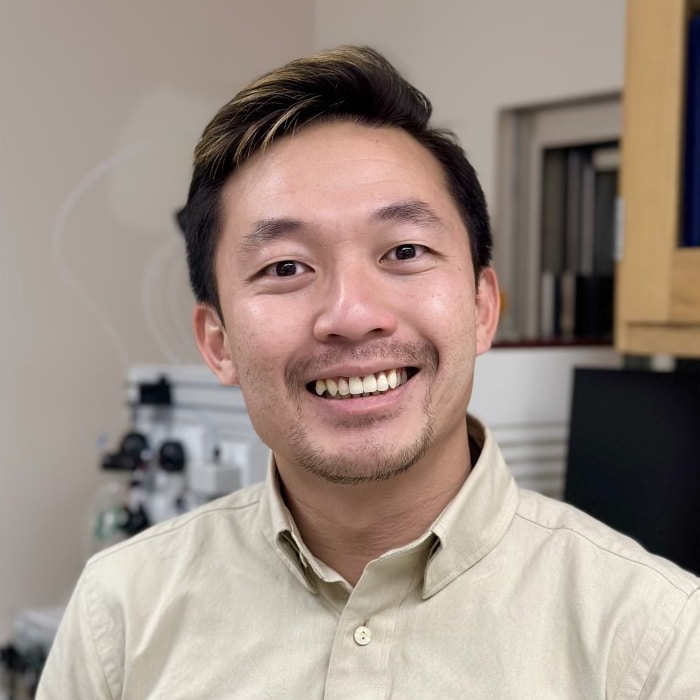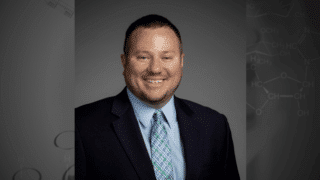 Meet Dr. Huu Hien Huynh! Dr. Huynh is one of the three newest fellows in our 2022 PCC Fellowship cohort, and you can learn more about him and his research in our interview below.
Meet Dr. Huu Hien Huynh! Dr. Huynh is one of the three newest fellows in our 2022 PCC Fellowship cohort, and you can learn more about him and his research in our interview below.
Background
Tell us about your educational background.
I’m an analytical chemist and metrologist, and I started my training with a pharmacy degree (PharmD) from the University of Paris Descartes, France. Concurrently, I earned a Master’s degree in chemical engineering from the Chimie ParisTech-PSL and a Master’s degree in analytical chemistry from the Paris Centre’s Master Network. Subsequently, I completed my PhD in proteomics and metrology as part of a collaboration between the ESPCI Paris-PSL and the French National Institute of Metrology (LNE).
What educational/professional opportunities helped you reach this point in your career?
My current focus is on the development of analytical methods for the quantification of biomarkers in biological fluids by coupling liquid chromatography with mass spectrometry. My mentor, Dr. Lauriane Goldwirt, introduced me to this area during my internship at the Laboratory of Pharmacology at the Saint-Louis Hospital, France. Following this, I found opportunities to learn about analytical chemistry in other fields, such as environmental science and food science, during my internships at Curtin University, Australia, and the Nestlé Research Center, Switzerland. During my PhD thesis, I adapted my skills and expertise with small molecules to the analysis of peptides/proteins in complex matrices and acquired expertise in metrology. In addition to my three excellent mentors, Dr. Joëlle Vinh, Dr. Vincent Delatour, and Dr. Amandine Boeuf, I was also able to work with outstanding international collaborators through two projects supported by the European Metrology Programme for Innovation and Research. After my PhD, I left Paris to diversify my training experience and joined Dr. Andy Hoofnagle’s laboratory at the University of Washington in Seattle, USA. My research has focused on sample preparation using antibodies for peptide-immunoaffinity enrichment. In his laboratory, I began my research career in anti-doping.
Why did you choose to go into anti-doping research?
To be honest, anti-doping was not the primary focus of my training. When I started my postdoctoral research, one of my projects was the development of a method to measure new biomarkers from the carboxyl-terminal region of type III procollagen in serum for the detection of growth hormone misuse, which was interesting. But I have really enjoyed working in close collaboration with highly qualified scientists around the world through the Collagen Turnover Working Group. Through this working group, I have developed an intense interest in the research and development of new methods and new biomarkers for anti-doping efforts. It’s an exciting field of science that constantly needs research to develop new and accurate methods to ensure integrity in sport and to protect the health of athletes.
Research
What do you find most interesting or exciting about your research area?
Anti-doping research has become one of the most interesting fields of investigation to me. Even though considerable progress has been made with respect to the analytical chemistry needed, the detection of doping remains challenging due to new substances being used and new methods that athletes are using to mask use. As a result, we need to constantly improve the quality of testing. In addition, I can pursue these research goals in a metrological context. Indeed, standardization/harmonization of the results across all laboratory settings all around the world is important to ensure fairness, especially because results are obtained from samples, collected in different venues and analyzed by different assay methods in laboratories around the world.
What are your plans for your PCC-supported research, and what ultimate findings do you expect to see?
The main goal of my proposal is to demonstrate the use of capillary blood as an alternative sample type for the quantification of peptides belonging to type III procollagen, which are biomarkers of growth hormone misuse. To achieve this goal, I need to develop a sensitive analytical method using a very small amount of blood. I am also hoping to improve upon finger-stick collection, which is convenient, but since the blood is collected as a blood spot, it can have unacceptable variability. To try to improve remote collection, I will investigate the use of a commercially available self-contained serum collection device, called Tasso+, to perform the capillary draw.
What impact will your research have on furthering the field of anti-doping?
The use of capillary blood as an effective sample type for the quantification of growth hormone biomarkers will allow more frequent sampling. In addition, I am trying to develop a single-point calibrator to help harmonize and standardize assays for collagen turnover so that all assays in all labs provide the same result.
Goals and PCC Benefits
How has PCC funding helped enable your research success?
The Partnership for Clean Competition Fellowship is allowing me to build my career in anti-doping research. The PCC supports my fellowship, as well as other projects in our laboratory that I have been working on. The PCC also provides a great networking opportunity through the Collagen Turnover Working Group and provides different platforms to share my research with the anti-doping community.
What have you gained from your fellowship experience, and what do you hope to accomplish?
I look forward to continuing my work with the PCC Collagen Turnover Working Group and other scientists in the anti-doping community. I also hope to achieve all of the goals of my proposed research project, which if successful, could be expanded to more routine use in anti-doping laboratories more broadly.
What are your long-term research or career goals?
I would like to continue to develop analytical methods with accuracy in mind. Throughout my fellowship, I will become more familiar with different aspects of anti-doping research and decide where I can contribute to the field in a significant way.



